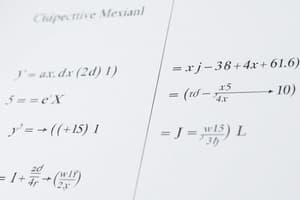Podcast
Questions and Answers
What is the main purpose of derivatives in calculus?
What is the main purpose of derivatives in calculus?
To determine how a function changes at a specific point by analyzing its slope.
How are derivatives denoted in calculus?
How are derivatives denoted in calculus?
The derivative of a function f(x) is denoted by f'(x) or df/dx.
What is the main purpose of integrals in calculus?
What is the main purpose of integrals in calculus?
To find the area under a curve or the accumulation of values of a function over a given interval.
What symbol is used to represent the operation of integration?
What symbol is used to represent the operation of integration?
Signup and view all the answers
What are some common techniques for finding derivatives and integrals?
What are some common techniques for finding derivatives and integrals?
Signup and view all the answers
In which fields are integrals commonly used?
In which fields are integrals commonly used?
Signup and view all the answers
How does calculus benefit the field of Economics?
How does calculus benefit the field of Economics?
Signup and view all the answers
What are some applications of calculus in Biology?
What are some applications of calculus in Biology?
Signup and view all the answers
What is the significance of differentiation and integration in calculus?
What is the significance of differentiation and integration in calculus?
Signup and view all the answers
How does calculus contribute to Computer Science?
How does calculus contribute to Computer Science?
Signup and view all the answers
Study Notes
Calculus: The Fascinating World of Derivatives and Integrals
Mathematics, with its intricate web of concepts and applications, presents a rich tapestry of subtopics, and calculus, a cornerstone of advanced mathematics, is no exception. Calculus enables us to explore the behavior of curves, analyze functions, and solve complex problems with remarkable precision. In this article, we'll delve into the fascinating world of calculus, specifically focusing on its subtopics of derivatives and integrals.
Derivatives
Derivatives, also known as instantaneous rates of change, allow us to determine how a function changes at a specific point by analyzing its slope. We use the notion of limits to approach the rate of change as we get closer and closer to a particular point. The derivative of a function f(x) is denoted by f'(x) or df/dx.
There are numerous applications of derivatives. For example, we can determine the speed of an object at a particular time by finding the derivative of its position function. Furthermore, we can analyze the behavior of a function's slope, identify local maxima, minima, and inflection points, and determine the concavity of a curve.
Integrals
Integrals, on the other hand, are the inverse operation of derivatives. They allow us to find the area under a curve, or the accumulation of values of a function over a given interval. The operation of integration is denoted by the symbol ∫.
Integrals are used in diverse fields, such as physics, where we calculate the work done by a force, the moment of a force about an axis, and the probability distribution of a random variable. In engineering, integrals are used to solve problems related to fluid flow, heat transfer, and wave propagation.
Differentiation and Integration Techniques
There are various techniques for finding derivatives and integrals. Some of the most common ones are:
- Power rule: Derivatives and integrals of power functions (x^n) are especially easy to find using the power rule.
- Sum rule: Derivatives and integrals of sums of functions are the sums of their derivatives and integrals, respectively.
- Product rule: Derivatives and integrals of products of functions involve a multiplication of their derivatives and integrals.
- Chain rule: Derivatives and integrals of composite functions involve the products of the derivative of the outer function and the derivative (or integral) of the inner function.
Applications of Calculus
Calculus has an abundance of applications in a variety of fields, including:
- Physics: Calculus helps us analyze the motion of particles, the behavior of waves, and the force experienced by objects.
- Engineering: Calculus is used in solving problems related to fluid flow, heat transfer, and wave propagation.
- Economics: Calculus helps us analyze supply and demand curves, production functions, and consumer surplus.
- Computer algorithms: Calculus is used in numerical methods for solving equations, finding roots, and approximating functions.
- Biology: Calculus is used in analyzing population dynamics, growth models, and the diffusion of substances in living organisms.
Final Thoughts
Calculus, with its subtopics of derivatives and integrals, is a powerful tool that allows us to analyze functions and solve complex problems. The applications of calculus are vast and diverse, spanning fields of physics, engineering, economics, computer science, and biology. With its roots in limits, differentiation, and integration, calculus is an invaluable resource for anyone seeking to understand the complexities of our world and the mathematical principles that govern it.
Studying That Suits You
Use AI to generate personalized quizzes and flashcards to suit your learning preferences.
Description
Explore the fascinating world of calculus through its subtopics of derivatives and integrals. Learn about instantaneous rates of change, finding areas under curves, differentiation techniques, integration techniques, and a wide range of applications in physics, engineering, economics, computer algorithms, and biology.




